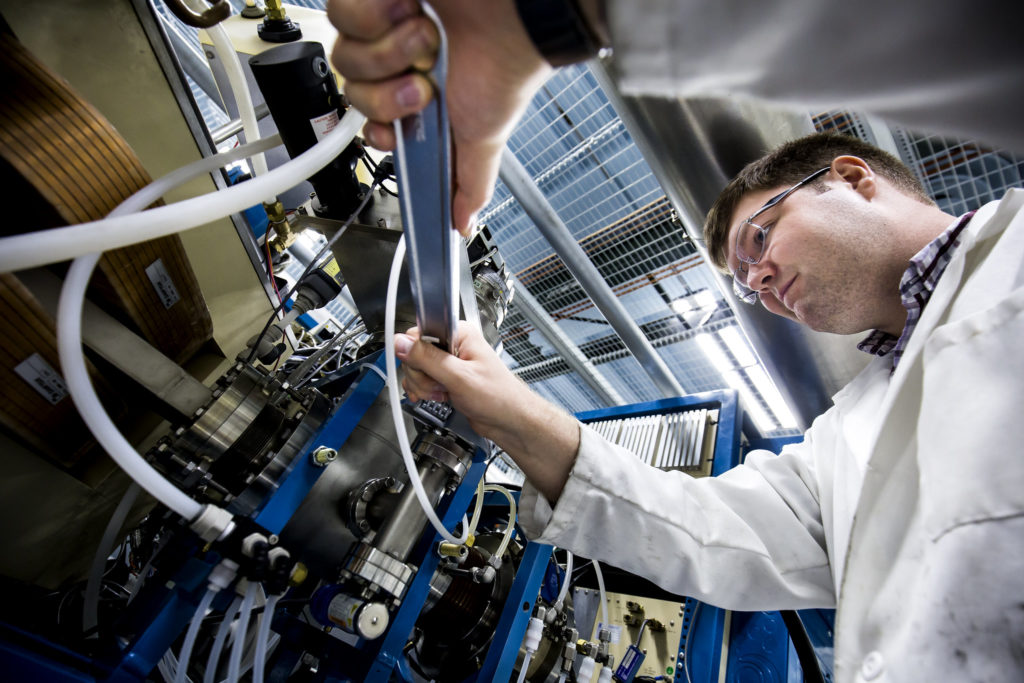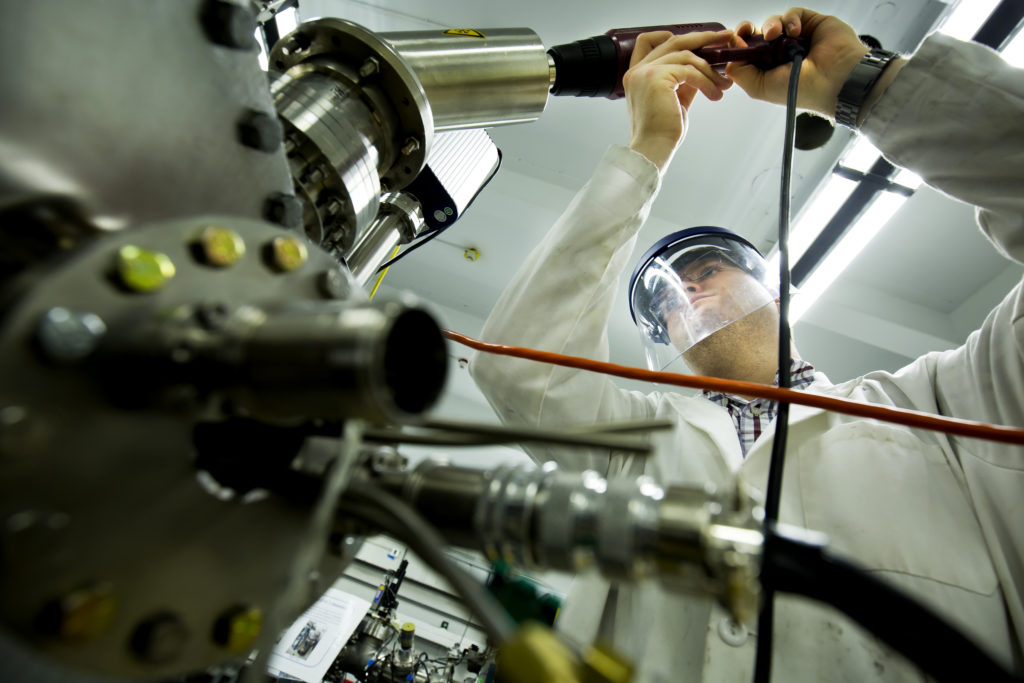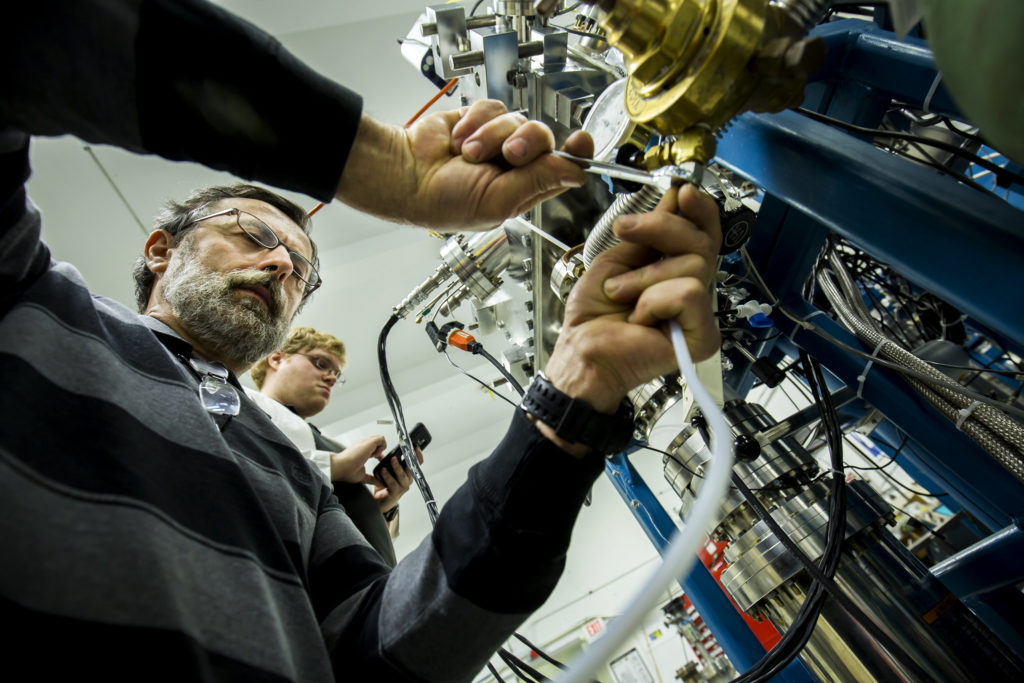
$5.1M to advance nuclear energy awarded to U-M
The Department of Energy will support research into better heat exchangers as well as improved predictions for neutron physics and radiation damage.

The Department of Energy will support research into better heat exchangers as well as improved predictions for neutron physics and radiation damage.
The U-M Department of Nuclear Engineering and Radiological Sciences has received $5.1 million funding for three projects to advance nuclear technology. The department is also collaborating on three more of the 74 projects that the US Department of Energy is supporting with a total of $61 million.
The biggest project U-M leads, funded with $4 million from the Integrated Research Projects program, is focused on compact heat exchangers, which would transfer heat from a nuclear reactor to the systems that use the heat directly or convert it to electricity. They are much smaller and thus less expensive than traditional designs.
Diffusion bonding, the process used to create compact heat exchangers, involves stacking grooved plates and pressing them together, causing the grooves to form channels. This new manufacturing technique creates a large number of small channels, which maximize the contact between the metal and the heated fluid, allowing more heat to pass through than in conventional heat exchangers.
However, high temperatures weaken the bonds between plates, limiting the heat exchangers to a lower temperature and eliminating the gains made by making them small. This project’s goal is to improve the knowledge of the bonding process to enable strong bonds at high temperatures.
“By bringing together the top experts from around the country, the research from this project will improve our ability to make lower cost and efficient heat exchangers that will decrease the overall costs associated with nuclear energy,” said Todd Allen, principal investigator of the project and the Glenn F. and Gladys H. Knoll Department Chair of Nuclear Engineering and Radiological Sciences.
Another U-M contributor is Fei Gao, a professor of nuclear engineering and radiological sciences. The project includes collaborators at the University of Wisconsin-Madison, Idaho National Laboratory, Argonne National Laboratory, the Electric Power Research Institute and the engineering firm MPR.

Funded with $600,000 by the Nuclear Energy University Partnerships program, Brendan Kochunas, an assistant professor of nuclear engineering and radiological sciences, will lead an effort to speed up the modeling of neutron physics for the software tools developed under the Nuclear Energy Advanced Modeling and Simulation program. Determining the distribution of neutrons in a reactor is critical to understanding the energy output, including how to ramp it up and how to shut it down.
Kochunas and his team will focus on developing new simulation methods that can be applied to advanced nuclear technologies based on SPn theory. The renewed interest in the almost 60-year-old SPn method comes in part from recent theoretical breakthroughs that improve the method’s accuracy.
“lt is humbling, and I feel grateful for this opportunity to lead an outstanding team of researchers in developing the next generation of SPn methods,” said Kochunas.
If successful, the new methods could substantially reduce advanced reactor design cycle times and lead to safer designs. Other U-M contributors are Brian Kiedrowski, an associate professor of nuclear engineering and radiological sciences, and Krishna Garikipati, a professor of mechanical engineering and mathematics. The project includes collaborators at Argonne National Laboratory, Oak Ridge National Laboratory and the Naval Nuclear Laboratory.
Funded with $500,000 from the Nuclear Energy University Partnerships program, Gary Was, professor emeritus and Kevin Field, associate professor, both of nuclear engineering and radiological sciences, lead a study of how radiation damage evolves through creep, which can shorten the lifespan of a nuclear power plant by potentially affecting all components of a nuclear reactor’s core.
Coupled with heat and neutron radiation in the reactor core, the mechanical stress causes metal components to slowly deform by a process known as creep. Because of these contributing factors, creep is extremely difficult to assess, and traditional testing cannot assess them independently. This project will use ion beam experiments to develop an understanding of how each individual factor affects creep, which will provide guidelines for the development of creep resistant alloys.
“Thermal and irradiation creep are deformation mechanisms that can limit the long term sustained operation of a nuclear power plant,” said Was. “However, traditional irradiation creep testing using neutron beams involves high costs and long lead times.”

The advantage of ion beams is that they can produce radiation damage much faster, and with additional computer modeling and simulation, they enable industry to predict when and how creep damage will progress. While data exists to make these predictions about radiation creep for current reactors, this project will produce both data and an understanding of radiation creep that is applicable to advanced reactor applications, for which the data is largely absent.
Other U-M contributors are Fei Gao, a professor of nuclear engineering and radiological sciences, and Priyam Patki, a former U-M postdoctoral research fellow and current process engineer at Intel Corporation.
In addition, nuclear faculty will support three other projects. One, led by the Massachusetts Institute of Technology, seeks to make nuclear fuel safer in the event of an accident with a new kind of cladding—the tubes that house fuel pellets. This project will test how the newly emerging accident tolerant fuel cladding behaves in a reactor environment. In order to assess the effects of radiation, Was and Field will conduct studies to determine the fuel’s baseline behavior of the cladding in a radiation-free environment. This study is supported by the Integrated Research Partnerships program.
Another, led by the University of Oklahoma, will engage communities where nuclear waste storage facilities may be sited at the design phase, bringing people to the table where decisions are made early on in the project, rather than expecting them to accept or reject a fully decided plan.
Allen, the project’s U-M lead, will lead expert workshops to create a list of design options that community members and technology developers might draw on to initiate a co-design process. Then, Denia Djokić, an assistant research scientist with expertise in nuclear waste and environmental justice, will co-design and host a Community Design Workshop to develop guidance on how to engage with communities.

The co-design forum, designed based on the practices explored in the workshop, will bring together community members and technical experts to collaboratively develop designs and plans for the nuclear waste site. Aditi Verma, who will become an assistant professor of nuclear engineering and radiological sciences this fall, will host it. Allen and Shanna Daly, an associate professor of mechanical engineering and director of research and evaluation at the Center for Socially Engaged Design, will participate in the forum.
Verma will also help recruit a diverse group of students and young scientists to participate in the project, which is supported by the Integrated Research Projects program.
The last project, led by the University of Wyoming, applies an environmental justice perspective to engaging with the Wyoming communities near a former coal plant where TerraPower and Pacificorp have proposed building an advanced reactor. Verma will conduct cultural research with the utility’s decision makers and reactor developers to understand how they currently incorporate community concerns into siting processes. Djokić will support Verma’s research and also help coordinate all of the research supporting the project, which is funded by the Nuclear Energy University Partnerships program.